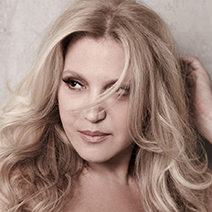Eliane Elias
Eliane Elias
Birdland, NYC, October 11, 2016
Reviewed by Marilyn Lester for Cabaret Scenes
 São Paulo-born Eliane Elias can be considered not only a musical national treasure of her native Brazil, but of her adoptive United States—so is it any wonder that Elias’ thrilling talent is an innovative fusion of Brazilian bossa nova and traditional straight ahead jazz? The opener for this Grammy Award winner was a swinging rendition of one of the most famous of Brazilian songs: “Aquarela do Brasil,” the 1939 composition by Ary Barroso that’s almost a national anthem. Elias’ musical template is to begin a number with vocals in bossa nova mode, and then swing into instrumental jazz, wherein she and her sidemen let loose. The result is a satisfying consistency of style containing surprising innovation. Her voice has that warm, smoky quality found in most female Brazilian singers, and her style is much like the great Gal Costa’s in its smooth, sure, hypnotic delivery.
São Paulo-born Eliane Elias can be considered not only a musical national treasure of her native Brazil, but of her adoptive United States—so is it any wonder that Elias’ thrilling talent is an innovative fusion of Brazilian bossa nova and traditional straight ahead jazz? The opener for this Grammy Award winner was a swinging rendition of one of the most famous of Brazilian songs: “Aquarela do Brasil,” the 1939 composition by Ary Barroso that’s almost a national anthem. Elias’ musical template is to begin a number with vocals in bossa nova mode, and then swing into instrumental jazz, wherein she and her sidemen let loose. The result is a satisfying consistency of style containing surprising innovation. Her voice has that warm, smoky quality found in most female Brazilian singers, and her style is much like the great Gal Costa’s in its smooth, sure, hypnotic delivery.
Of course the legendary Carioca (a native of Rio de Janeiro), Antonio Carlos (Tom) Jobim was liberally represented. He was on the cutting edge of the revolutionary new music called bossa nova (essentially jazzed-up samba), which came on the Brazilian music scene in the late 1950s. An early Jobim, “Chega de Saudade” (with Vinicius De Moraes) featured a smooth guitar introduction by Marcus Teixeira and extended solos by bassist Marc Johnson and drummer Rafael Barata, whose work is generally reminiscent of traditional Brazilian samba bands. Jobim (with whom Elias toured back in the day) was also represented with “Samba de Uma Nota So” (with Newton Mendonça), with Elias playing a honeyed river of notes within the traditional beat. “So Danço Samba” and “Garota de Ipanema” (both Jobim/De Moraes) were finely executed, along with a stunning, extended “Desafinado” (Jobim/Mendonça) featuring a melodic bass solo by Johnson and a lengthy, mind-blowing tour de force of power drumming in true samba style by Barata.
Elias’ piano playing is fluid, confident and relaxed, even with the most jazzy, up-tempo and frenetic pieces. She’s influenced by classical training and the playing of early bossa nova master João Donato, as well as the late Bill Evans, whom she greatly admires. As a tribute to Evans, Elias played solo “I Love My Wife” (Cy Coleman/Michael Stewart) in which each hand spoke volumes on the keys. Another solo, a spirited, jazzy versions of the Gershwins’ “Liza” displayed creative variations on the melody. On the lighter side, she sang the 1948 novelty song “O Pato” (“The Duck”; Jaime Silva/Neuza Teixeira), which is as good as any a way of acknowledging the Brazilian capacity for happiness and good cheer (even among hardship) embodied in bossa nova and in Elias herself.
Category: Cabaret Reviews, New York City, New York City Cabaret Reviews, Regional






